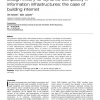Free Online Productivity Tools
i2Speak
i2Symbol
i2OCR
iTex2Img
iWeb2Print
iWeb2Shot
i2Type
iPdf2Split
iPdf2Merge
i2Bopomofo
i2Arabic
i2Style
i2Image
i2PDF
iLatex2Rtf
Sci2ools
JITECH
2010
2010
Design theory for dynamic complexity in information infrastructures: the case of building internet
We propose a design theory that tackles dynamic complexity in the design for Information Infrastructures (IIs) defined as a shared, open, heterogeneous and evolving socio-technical system of Information Technology (IT) capabilities. Examples of IIs include the Internet, or industry-wide Electronic Data Interchange (EDI) networks. IIs are recursively composed of other infrastructures, platforms, applications and IT capabilities and controlled by emergent, distributed and episodic forms of control. II’s evolutionary dynamics are nonlinear, path dependent and influenced by network effects and unbounded user and designer learning. The proposed theory tackles tensions between two design problems related to the II design: (1) the bootstrap problem: IIs need to meet directly early users’ needs in order to be initiated; and (2) the adaptability problem: local designs need to recognize II’s unbounded scale and functional uncertainty. We draw upon Complex Adaptive Systems theory to derive...
Related Content
| Added | 28 Jan 2011 |
| Updated | 28 Jan 2011 |
| Type | Journal |
| Year | 2010 |
| Where | JITECH |
| Authors | Ole Hanseth, Kalle Lyytinen |
Comments (0)

